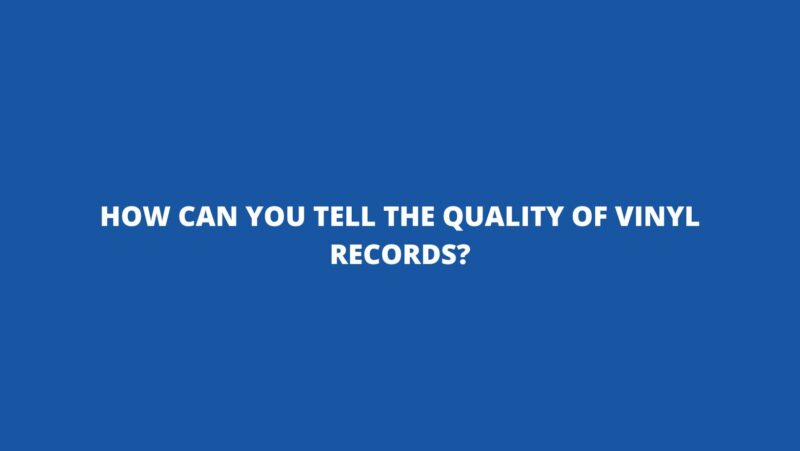In a world of digital music consumption, the allure of vinyl records endures, offering a tactile and auditory experience that captivates enthusiasts and audiophiles alike. Central to this experience is the quality of the vinyl record itself. Whether you’re a seasoned collector or a newcomer to the vinyl realm, understanding how to assess the quality of vinyl records is essential to ensure a rewarding listening experience. This article serves as an in-depth guide to help you navigate the grooves and discern the various aspects that contribute to the quality of vinyl records.
The Importance of Vinyl Record Quality
The quality of a vinyl record significantly impacts the sound it produces, influencing factors such as fidelity, clarity, and overall enjoyment. Recognizing the indicators of a high-quality record not only enhances your listening pleasure but also allows you to make informed decisions when building or expanding your collection.
Factors to Consider When Assessing Vinyl Record Quality
- Vinyl Composition: High-quality vinyl records are typically made from virgin vinyl, which contains no recycled materials. Virgin vinyl is less prone to surface noise, warping, and defects compared to records made from recycled vinyl.
- Weight and Thickness: Heavier and thicker records tend to offer better sound quality. Standard records are usually 140-180 grams, while audiophile or high-end releases can be 200 grams or more.
- Surface Smoothness: The surface of the vinyl should be smooth and free from visible defects, such as pits, scratches, or dimples. These imperfections can cause playback issues and affect sound quality.
- Center Hole Alignment: The center hole of the record should be precisely aligned with the spindle hole of your turntable. Misaligned center holes can cause the record to wobble during playback, leading to pitch fluctuations.
- Groove Depth and Alignment: Well-defined and evenly spaced grooves are indicative of a high-quality pressing. Shallow grooves or variations in groove depth can affect tracking and fidelity.
- Edge Warping: Inspect the edge of the record for any signs of warping. Warped records can cause the stylus to skip or produce uneven sound.
- Surface Noise and Scratches: Hold the record up to a light source to check for surface scratches and scuffs. Excessive scratches can create audible pops and crackles during playback.
- Label Alignment: The label in the center of the record should be properly aligned. Off-center labels can cause balance issues during playback.
- Print Quality of Album Cover: If the record is accompanied by an album cover, assess the print quality, paper type, and overall condition. A well-preserved album cover often indicates a well-maintained record.
- Runout Groove Etchings: The runout groove area contains etchings that provide information about the mastering and pressing. High-quality records often have clean and legible etchings.
Assessing Sound Quality
- Fidelity and Clarity: High-quality vinyl records offer clear and detailed sound with minimal distortion. Instruments and vocals should be well-defined, and the soundstage should have depth and dimension.
- Dynamic Range: A quality record should accurately reproduce the full dynamic range of the music, from soft whispers to loud crescendos. Compression and distortion should be minimal.
- Background Noise: A well-pressed record minimizes background noise, such as hiss or hum. Low-quality records may have a noticeable layer of background noise that detracts from the listening experience.
- Channel Balance: The left and right channels should be balanced, with no significant differences in volume or sound quality between them.
- Sibilance and Inner Groove Distortion: Listen for sibilance (harsh “s” and “sh” sounds) and inner groove distortion, which can occur on records with excessive high-frequency content or improper tracking.
- Skipping and Pops: A quality record should play smoothly without skipping or producing frequent pops and clicks. Prolonged skipping indicates issues with the groove geometry or stylus.
- Surface Noise: While some surface noise is inherent in vinyl playback, excessive noise can indicate a poorly pressed or worn record.
Conclusion
Assessing the quality of vinyl records is an art that combines visual inspection, tactile evaluation, and attentive listening. As you navigate the world of vinyl, developing a discerning eye and ear will empower you to make informed decisions when purchasing, collecting, and enjoying vinyl records. By considering factors such as vinyl composition, weight, groove alignment, surface smoothness, and sound quality, you can build a collection that not only reflects your musical taste but also delivers a superior listening experience. As the turntable spins and the stylus dances along the grooves, the quality of the vinyl will shape your journey into the rich and immersive world of analog sound.


